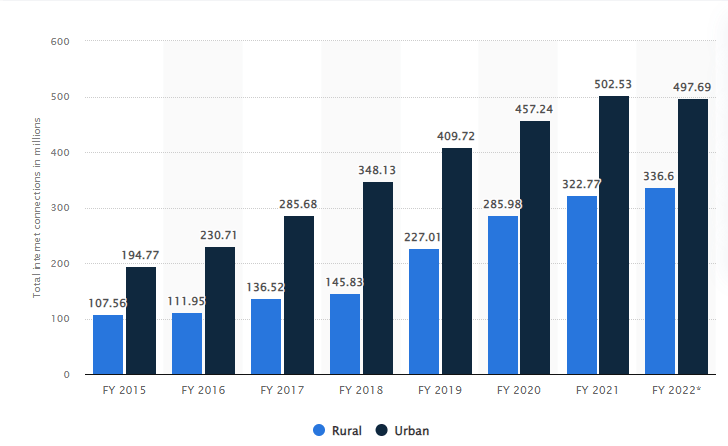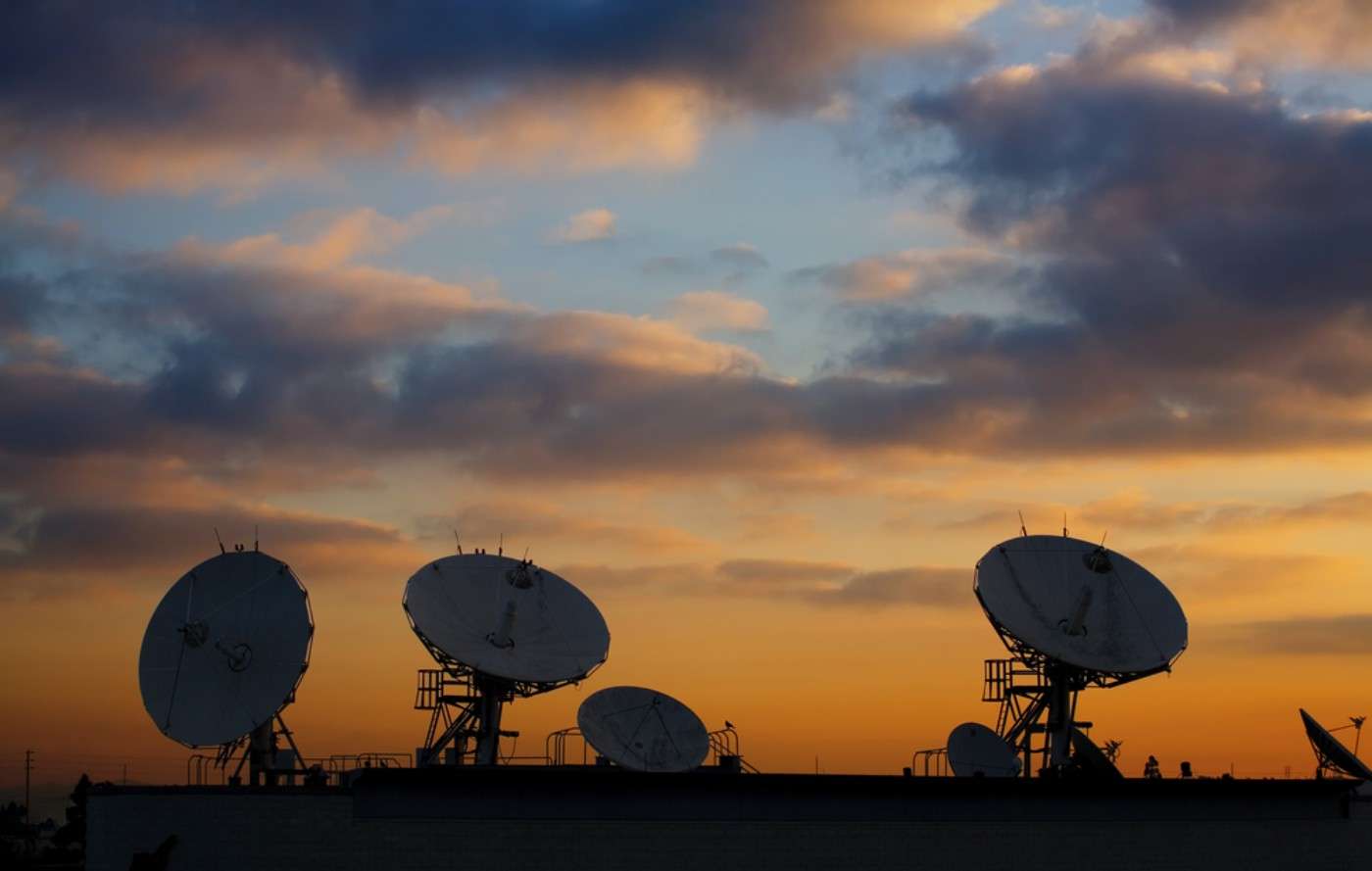
With a rural-urban area distribution of 68.84% and 31.16%, respectively, India is a predominantly rural-centric country. However, development-wise, urban areas are better placed than rural areas for various reasons. One of the top indicators of these differences is internet connectivity. But the scenarios are changing now, and there has been an appreciable increase in internet usage in rural India in recent years.
In the year 2022, the total number of internet connections in India will have reached about 834.29 million. Now, there are 497.69 million internet connections in urban areas and 336.6 million in rural areas, respectively. We can see that internet access in rural areas is getting closer to what it is in cities, thanks to many government and private telecom sector projects. To make the Digital India program a success, the central government has prioritised universal broadband to ensure better governance through technology. The BharatNet project was started in 2011 so that broadband could be brought to about 650,000 villages in India.
Due to COVID-19 and other obstacles, there are delays in implementation, forcing the concerned authorities to look at other technologies beyond optical fibre and mobile communications. So, we are seeing policy changes to use satellite broadband networks to make sure that people in rural areas can connect to the internet in a big way. But, can satellite broadband replace optical fibre in the future, or is fibre still the best method to achieve full rural internet connectivity? Let’s find out the answers by making valid comparisons between fibre and satellite broadband technologies.

Number of internet connections in rural and urban areas since 2015
BharatNet project status as of July 25, 2022

BharatNet current fibre rollout
How Does Fibre Broadband Work?

Fibre Broadband
Fibre broadband is typically provided through fiber optic cables comprising multiple fibre strands with thicknesses similar to human hair. These fibres carry data or information in light packets and can travel hundreds of kilometres. These signals are much faster than electrical signals and don’t have a significant drop over distance. A regular fibre optic cable is stacked with two elements made from glass materials that are called the core and the clad. The light signals are transferred via the core. The cladding is placed around the core, preventing the light signals from escaping, thereby minimising the drop. A fibre is long-lasting and made for the future, as the data transfer capacity via a fibre cable is significantly higher than that of an RF (radio frequency) carrier. This enables making data capacity improvements via equipment upgrades way before the fibre upgrade.
How Does Satellite Broadband Work?

Satellite Broadband
Satellite broadband uses radio frequency (RF) to connect satellites in orbit with antennas on the ground. Telco players like Bharti Airtel and Reliance Jio are launching satellite broadband in India and competing to grab the rural broadband market. As the need for broadband in cities reaches its limit, these companies see a lot of potential in rural areas. There are 3 types of communication satellites utilised for providing satellite broadband:
GEO (geostationary) satellites: These revolve in a circular orbit above the equator and are placed at a consistent distance of 35,786 km. GEO satellites orbit in alignment with the earth’s rotation about its axis for 24 hours. Hence, they remain at the same point above the earth. Usually, coverage is not possible at +/- 70 degrees latitude from the position of the equator. As they are placed at a higher distance from the surface of the earth, only three satellites can be utilised to offer full coverage. These have longer delays than their MEO and LEO satellites, and because the earth is curved, they can’t cover both poles completely.
MEO (Medium-Earth Orbit) satellites: These take between 2 and 24 hours to circle around the earth at an altitude ranging from 2000 km to 35,786 km from the earth’s surface. As they are closer to the planet than GEO satellites, they have far less latency than them. MEO satellites that orbit about 8000 km above the equator will have a latency of less than 150 ms, but they will need help from other satellites to cover the whole equator. Around 8 satellites can offer continuous coverage in the narrow band.
LEO (low-Earth orbit) satellites: These orbit around the earth quickly, within two hours. LEO satellites usually orbit very close to the earth’s surface, ranging from 500 km to 1600 km. They are closer to the earth than GEO and MEO satellites, so they can offer high speeds and very low latency. They are also much smaller than other satellites, making them easier to produce and relatively inexpensive. However, their closeness to the earth means that a large group of satellites is necessary to provide full global coverage.
Difference between Fibre and Satellite Broadband in key areas
- Reliability
Since satellites are in space and orbit from a long way away, latency problems are widespread. Only LEO satellites exhibit less latency compared to MEO and GEO. Since satellite broadband works as a wireless connecting system, it is prone to interference which is more than fibre broadband, a system hardwired and shows steady performance. In addition, trees, buildings, or inclement weather conditions can significantly reduce the signal strength of a satellite connection making it less reliable. On the other hand, fibre broadband works underground and is protected from external interferences like weather, trees, etc., to a large extent.
- Price
Satellite broadband has a higher initial installation cost, along with higher monthly tariffs. If you compare the internet expenses of satellite connections to other types of internet services offered in terms of speed and other factors, the cost tends to be much higher in most locations. Contrastingly, fibre broadband is much more affordable, and the tariff varies based on speed, territory, etc. This is a crucial factor, as rural residents’ monthly income is significantly lower than that of urban citizens, making satellite broadband out of reach for most rural households due to higher costs.
- Availability
In most rural areas of India, there is a power shortage and insufficient infrastructure to host fibre broadband. Hence, satellite broadband might be a better option. For satellite broadband connectivity to work effectively, only a clear view of the satellites, a power-generating source to receive the radio frequency signal, and a terminal are needed. In contrast, fibre is difficult to access, mainly in remote village areas. However, even in urban areas, we have mostly incorporated FTTC (Fiber to the Curb). This means that you need DSL or fiber optic cables to connect the “last mile” to the home. FTTH, or fiber to the home, refers to the use of optical fiber cables to connect homes to a central terminal rather than DSL or coaxial cables. FTTH offers higher speeds than FTTC and is therefore superior.
- Speed
Satellite broadband speeds have improved significantly in recent times. Previously, satellite internet services offered to homes were extremely slow, providing data speeds of around 750 kbps, which is not enough to prevent buffering or downloading documents quickly. Due to numerous advancements in satellite broadband technology, like utilising the higher capacity RF spectrum, we can now enjoy data speeds of up to 100 Mbps based on the tariff, location, and service provider. On the other hand, fibre broadband speeds can reach 1 GB/s or more, depending on the tariff plan selected and the internet service provider.
Verdict
Based on the above comparisons, we cannot declare a clear winner between fibre broadband vs satellite broadband. There is no one solution considered best to provide internet connectivity to both urban and rural areas. What might work for urban locations might not be beneficial for rural areas. Both fibre broadband and satellite broadband have their merits and demerits. But the affordability aspect is really an obstacle for rural areas, as the monthly income is lower, making fibre broadband a better choice than satellite broadband. In any case, combining fiber broadband and satellite broadband in rural areas can help meet internet connectivity demands more quickly. Fingers are crossed; we can only hope rural internet connectivity matches urban areas within a few years!















